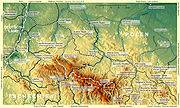
Silesian Mountain Railway
Encyclopedia

Poland
Poland , officially the Republic of Poland , is a country in Central Europe bordered by Germany to the west; the Czech Republic and Slovakia to the south; Ukraine, Belarus and Lithuania to the east; and the Baltic Sea and Kaliningrad Oblast, a Russian exclave, to the north...
. It leads from Görlitz
Görlitz
Görlitz is a town in Germany. It is the easternmost town in the country, located on the Lusatian Neisse River in the Bundesland of Saxony. It is opposite the Polish town of Zgorzelec, which was a part of Görlitz until 1945. Historically, Görlitz was in the region of Upper Lusatia...
/Zgorzelec
Zgorzelec
Zgorzelec is a town in south-western Poland with 33,278 inhabitants . It lies in Lower Silesian Voivodeship . It is the seat of Zgorzelec County, and also of the smaller district of Gmina Zgorzelec...
on the Lusatian Neisse
Lusatian Neisse
The Lusatian Neisse is a long river in Central Europe. The river has its source in the Jizera Mountains near Nová Ves nad Nisou, Czech Republic, reaching the tripoint with Poland and Germany at Zittau after , and later forms the Polish-German border on a length of...
via Jelenia Góra
Jelenia Góra
----Jelenia Góra is a city in Lower Silesia, south-western Poland. The name of the city means "deer mountain" in Polish, Czech and German. It is close to the Krkonoše mountain range running along the Polish-Czech border – ski resorts such as Karpacz and Szklarska Poręba can be found...
to Wałbrzych in Lower Silesia
Lower Silesia
Lower Silesia ; is the northwestern part of the historical and geographical region of Silesia; Upper Silesia is to the southeast.Throughout its history Lower Silesia has been under the control of the medieval Kingdom of Poland, the Kingdom of Bohemia and the Austrian Habsburg Monarchy from 1526...
.
The first plans for connection of Görlitz with Waldenburg (Wałbrzych) via Hirschberg (Jelenia Góra) and further to Glatz (Kłodzko) appeared in 1853. The Kingdom of Prussia
Kingdom of Prussia
The Kingdom of Prussia was a German kingdom from 1701 to 1918. Until the defeat of Germany in World War I, it comprised almost two-thirds of the area of the German Empire...
intended to build a direct railway link from Berlin
Berlin
Berlin is the capital city of Germany and is one of the 16 states of Germany. With a population of 3.45 million people, Berlin is Germany's largest city. It is the second most populous city proper and the seventh most populous urban area in the European Union...
to Vienna
Vienna
Vienna is the capital and largest city of the Republic of Austria and one of the nine states of Austria. Vienna is Austria's primary city, with a population of about 1.723 million , and is by far the largest city in Austria, as well as its cultural, economic, and political centre...
, bypassing the Kingdom of Saxony
Kingdom of Saxony
The Kingdom of Saxony , lasting between 1806 and 1918, was an independent member of a number of historical confederacies in Napoleonic through post-Napoleonic Germany. From 1871 it was part of the German Empire. It became a Free state in the era of Weimar Republic in 1918 after the end of World War...
. However, the Austrian Empire
Austrian Empire
The Austrian Empire was a modern era successor empire, which was centered on what is today's Austria and which officially lasted from 1804 to 1867. It was followed by the Empire of Austria-Hungary, whose proclamation was a diplomatic move that elevated Hungary's status within the Austrian Empire...
did not favor a construction major railway line running parallel to its border.
As the industrialization of Germany progressed, the original plan was reconsidered several years later. On 24 September 1862 the Prussian parliament approved construction of a railway line from Görlitz to Waldenburg with a branch line to Kohlfurt (Węgliniec
Wegliniec
Węgliniec is a town in Zgorzelec County, Lower Silesian Voivodeship, in south-western Poland. It is the seat of the administrative district called Gmina Węgliniec...
). The line was built stepwise; the last section was opened on 16 August 1867. The first section was electrified by 1915. Due to the First World War the electrification was not finished until 1923.
The railway was one of the first German electrified lines
Railway electrification system
A railway electrification system supplies electrical energy to railway locomotives and multiple units as well as trams so that they can operate without having an on-board prime mover. There are several different electrification systems in use throughout the world...
. Before the Second World War it was used to transport vast amounts of Silesian hard coal to Saxony and the Province of Brandenburg
Province of Brandenburg
The Province of Brandenburg was a province of the Kingdom of Prussia and the Free State of Prussia from 1815 to 1946.-History:The first people who are known to have inhabited Brandenburg were the Suevi. They were succeeded by the Slavonians, whom Henry II conquered and converted to Christianity in...
. The railway was included in Polish territory in 1945 according to the post-war Potsdam Agreement
Potsdam Agreement
The Potsdam Agreement was the Allied plan of tripartite military occupation and reconstruction of Germany—referring to the German Reich with its pre-war 1937 borders including the former eastern territories—and the entire European Theatre of War territory...
.

